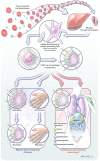Progression of pathogenic events in cynomolgus macaques infected with variola virus
- PMID: 21998632
- PMCID: PMC3188545
- DOI: 10.1371/journal.pone.0024832
Progression of pathogenic events in cynomolgus macaques infected with variola virus
Abstract
Smallpox, caused by variola virus (VARV), is a devastating human disease that affected millions worldwide until the virus was eradicated in the 1970 s. Subsequent cessation of vaccination has resulted in an immunologically naive human population that would be at risk should VARV be used as an agent of bioterrorism. The development of antivirals and improved vaccines to counter this threat would be facilitated by the development of animal models using authentic VARV. Towards this end, cynomolgus macaques were identified as adequate hosts for VARV, developing ordinary or hemorrhagic smallpox in a dose-dependent fashion. To further refine this model, we performed a serial sampling study on macaques exposed to doses of VARV strain Harper calibrated to induce ordinary or hemorrhagic disease. Several key differences were noted between these models. In the ordinary smallpox model, lymphoid and myeloid hyperplasias were consistently found whereas lymphocytolysis and hematopoietic necrosis developed in hemorrhagic smallpox. Viral antigen accumulation, as assessed immunohistochemically, was mild and transient in the ordinary smallpox model. In contrast, in the hemorrhagic model antigen distribution was widespread and included tissues and cells not involved in the ordinary model. Hemorrhagic smallpox developed only in the presence of secondary bacterial infections - an observation also commonly noted in historical reports of human smallpox. Together, our results support the macaque model as an excellent surrogate for human smallpox in terms of disease onset, acute disease course, and gross and histopathological lesions.
Conflict of interest statement
Figures







Similar articles
-
Exploring the potential of variola virus infection of cynomolgus macaques as a model for human smallpox.Proc Natl Acad Sci U S A. 2004 Oct 19;101(42):15196-200. doi: 10.1073/pnas.0405954101. Epub 2004 Oct 11. Proc Natl Acad Sci U S A. 2004. PMID: 15477589 Free PMC article.
-
Acute Late-Stage Myocarditis in the Crab-Eating Macaque Model of Hemorrhagic Smallpox.Viruses. 2021 Aug 9;13(8):1571. doi: 10.3390/v13081571. Viruses. 2021. PMID: 34452435 Free PMC article.
-
Use of live Variola virus to determine whether CAST/EiJ mice are a suitable surrogate animal model for human smallpox.Virus Res. 2020 Jan 2;275:197772. doi: 10.1016/j.virusres.2019.197772. Epub 2019 Oct 5. Virus Res. 2020. PMID: 31593747 Free PMC article.
-
Animal models of orthopoxvirus infection.Vet Pathol. 2010 Sep;47(5):852-70. doi: 10.1177/0300985810378649. Epub 2010 Aug 3. Vet Pathol. 2010. PMID: 20682806 Review.
-
Comparative pathology of smallpox and monkeypox in man and macaques.J Comp Pathol. 2013 Jan;148(1):6-21. doi: 10.1016/j.jcpa.2012.06.007. Epub 2012 Aug 11. J Comp Pathol. 2013. PMID: 22884034 Free PMC article. Review.
Cited by
-
Smallpox lesion characterization in placebo-treated and tecovirimat-treated macaques using traditional and novel methods.PLoS Pathog. 2024 Feb 22;20(2):e1012007. doi: 10.1371/journal.ppat.1012007. eCollection 2024 Feb. PLoS Pathog. 2024. PMID: 38386661 Free PMC article.
-
Pharmacokinetic and pharmacodynamic modeling to determine the dose of ST-246 to protect against smallpox in humans.Antimicrob Agents Chemother. 2013 Mar;57(3):1136-43. doi: 10.1128/AAC.00959-12. Epub 2012 Dec 17. Antimicrob Agents Chemother. 2013. PMID: 23254433 Free PMC article.
-
Primary human macrophages serve as vehicles for vaccinia virus replication and dissemination.J Virol. 2014 Jun;88(12):6819-31. doi: 10.1128/JVI.03726-13. Epub 2014 Apr 2. J Virol. 2014. PMID: 24696488 Free PMC article.
-
Efficacy of tecovirimat (ST-246) in nonhuman primates infected with variola virus (Smallpox).Antimicrob Agents Chemother. 2013 Dec;57(12):6246-53. doi: 10.1128/AAC.00977-13. Epub 2013 Oct 7. Antimicrob Agents Chemother. 2013. PMID: 24100494 Free PMC article.
-
Effect of Monkeypox Virus Preparation on the Lethality of the Intravenous Cynomolgus Macaque Model.Viruses. 2022 Aug 9;14(8):1741. doi: 10.3390/v14081741. Viruses. 2022. PMID: 36016363 Free PMC article.
References
-
- Hopkins DR. Chicago: University of Chicago Press; 2002. The Greatest Killer: Smallpox in History.
-
- Fenner F. The eradication of smallpox. Prog Med Virol. 1977;23:1–21. - PubMed
-
- Fenner F. The global eradication of smallpox. Med J Aust. 1980;1:455–455. - PubMed
-
- Fenner F. A successful eradication campaign. Global eradication of smallpox. Rev Infect Dis. 1982;4:916–930. - PubMed
-
- Fenner F. Smallpox: emergence, global spread, and eradication. Hist Philos Life Sci. 1993;15:397–420. - PubMed
Publication types
MeSH terms
Grants and funding
LinkOut - more resources
Full Text Sources
Medical
Molecular Biology Databases

